M4A3 76mm Medium Tanks of the 752nd
 |
| "B" Company tankers play a game of poker while awaiting orders during the Spring of 1945. Note the processing and delivery stencils on the sponson, as well as several handwritten chalk marks. |
- Researched and Written by Robert Holt -
M4A3
76mm Tanks in the Combat Period
Although the exact date is not known, the 752nd Tank Battalion received
a small number of its first M4A3 76mm tanks sometime in very late
Autumn of 1944. It is believed that the battalion initially received
about 15 of these tanks, because records later refer to "the remaining
39" M4 and M4A1 tanks being exchanged for M4A3s. A report covering the
period ending 25 November 1944 says that the battalion had fired 2,750
76mm rounds in the six months ending on that date. The 752nd's firing
records for subsequent months in the Northern Apennine campaign
indicates that 2,750 rounds would be considerably less than a company's
monthly firing. It is not known which company or companies received the
first M4A3 tanks, or how they were initially deployed. Regardless when
the first M4A3s were received, the record states that the tankers "were
strictly in favor of the new high velocity weapon."
On 24 February 1945, the 752nd began exchanging the balance of its war-weary M4 and M4A1 tanks for 76mm M4A3 tanks. This process required the careful and methodical withdrawal of old tanks from static positions they had occupied for nearly 4 months. Many of the old tanks were literally frozen into position in the Northern Apennine mountains. The process was completed by 7 March 1945, and on that date the 752nd's "official" inventory consisted exclusively of M4A3 76mm VVSS tanks. However, in anticipation of the Spring Offensive, the 752nd retained several of its old M4 and M4A1 tanks as excess inventory. This was done to provide a fleet of older, more expendable tanks to be used as lead vehicles when crossing minefields in the push out of the mountains toward the Po Valley. A number of old M4/M4A1 tanks were in fact lost this way during the Spring Offensive, thus sparing the newer, more effective vehicles.
All of the M4A3 tanks that the 752nd used in combat utilized the old VVSS suspension system. The battalion does not appear to have received any of the newer HVSS vehicles until well into the postwar period. The first photos of HVSS tanks in the 752nd appear in early November 1946.
The 752nd's combat-era M4A3 76mm tanks varied considerably in terms of equipment and marking details. Photos show mainly T48 rubber track blocks in use, but some tanks were also equipped with T51 rubber track blocks. A few photos showing T54 steel track blocks have been found, and even T49 and the very rare T62 steel track blocks have been seen in photos of 752nd M4A3 tanks (see photos below).
While many of the 752nd's M4A3s were fitted with the muzzle brake, it appears that nearly as many vehicles lacked it as had it. There was also a difference in the type of loader's hatches used. While the oval loader's hatch seems to have been far more common, several photos also show the round loader's hatch in use.
All of the 752nd M4A3 76mm tanks had grouser racks welded onto both sides of the turret. While most combat vehicles in the battalion seem to have their racks filled with grousers, some vehicles in the same period had empty or near-empty racks, thus exposing the Allied star and providing a different look. The "luggage rack" field expedients that were welded onto the rear decks of some of the battalion's old M4's do not appear on any photos of the M4A3s.
As with the old M4 and M4A1 tanks, the 752nd does not appear to have standardized its M4A3 vehicle markings until the postwar period. During the combat period, some tanks had no Allied stars on their turret, others had a "star in circle" on the turret, and others had a plain star on the turret's side. In most cases, these stars were obscured by the grouser rack if the grousers were in place. Those vehicles that used the "star in circle" on the turret also generally had a large "star in circle" on the transmission cover. Though high-angle photos are rare, some show a small plain star on the top surface of the turret, and others have no star on the turret top. No photos have surfaced yet of stars on the rear deck, likely because the 752nd relied heavily on the more effective air recognition panels during the later phases of the war. The large tactical numbers that had been used on the old M4s and M4A1s earlier in the war were not used on the M4A3 vehicles.
Bumper codes still do not appear to be common or standardized on the battalion's 76mm M4A3s during the combat period. Nicknames were painted on the sides of only a few combat-era M4A3s, such as the upswept name "Betsy 2" on the side of Major Woodbury's tank, or the tank named "Lady Anna" (see photos below). The use of tank names seems to have become almost standard in the postwar period.
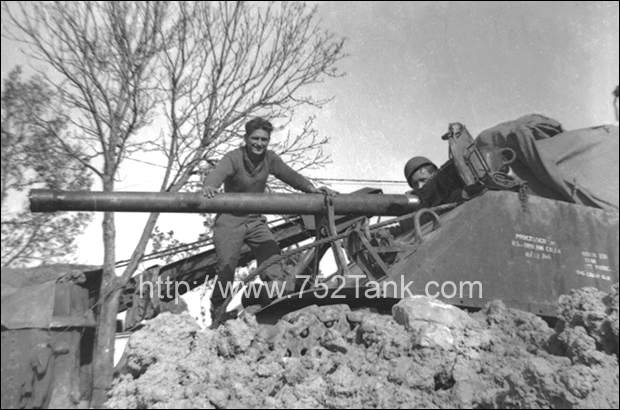 |
 |
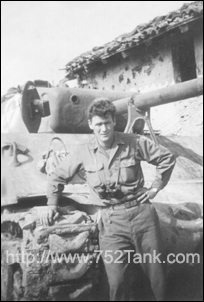 |
 |
 |
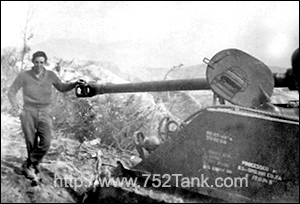 |
|
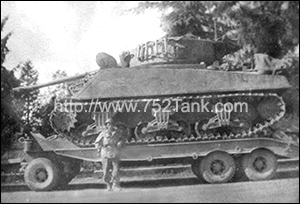 |
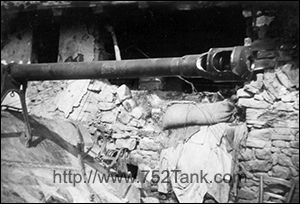 |
|
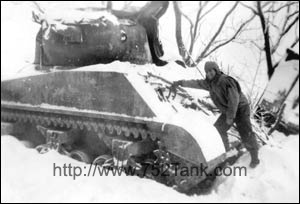 |
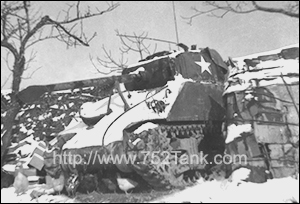 |
|
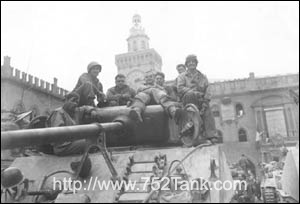 |
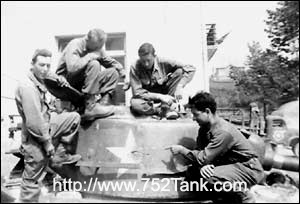 |
|
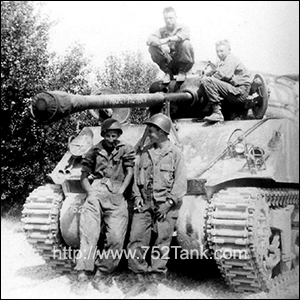 |
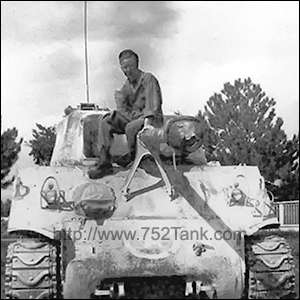 |
The 752nd Tank Battalion retained its M4A3 VVSS tanks well into the postwar period. The first evidence of an M4A3 tank in the 752nd with a newer HVSS suspension system is dated 8 November 1946. During the postwar period, military discipline and regulations returned to the 752nd, and this is reflected in the tanks themselves. Standard vehicle bumper codes were employed for the first time. The tanks were more freshly painted, and in some cases they almost appear to shine. One distinctive feature of the 752nd's postwar tanks is the use of a small tactical number on the turret's pistol port. The pistol port was painted white, and a dark-colored tactical number was painted on top of the white port, resulting in an easily distinguished vehicle number (see photo below).
Nicknames appear to be in standard use in the battalion during the postwar period. The names appeared in neatly stenciled letters toward the front of each sponson. The naming convention generally seems to have adhered to the convention of naming tanks with the company's first letter. For example, "B" Company tanks in the postwar period went by names such as Big Mike, Baker's Best, Blonde Buster, and Billy The Kid.
After the 752nd was inactivated in 1947, many of its men and vehicles went on to form the 15th Tank Company, known less formally as Trust Tanks. These tanks were employed in peacekeeping activities on the hostile border between Italy and Yugoslavia. The HVSS tanks shown in the photos below are from the 15th Tank Company, taken by the Signal Corps in December 1947, January 1948, and August 1948.
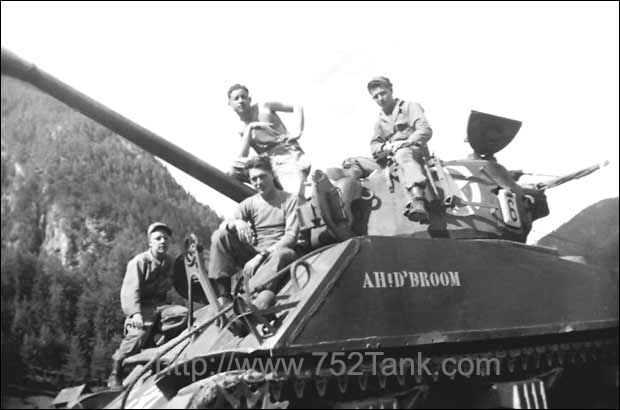 |
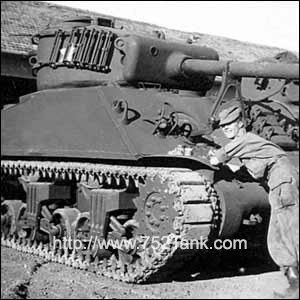 |
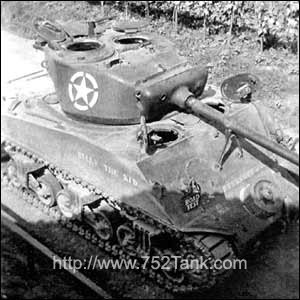 |
|
 |
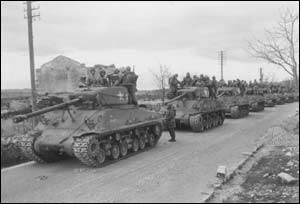 |
|
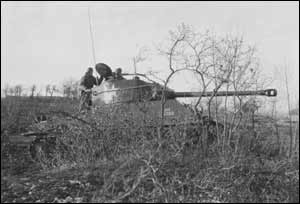 |
 |
M4 & M4A1 75mm Sherman Medium Tanks
M3/M5 Stuart & M24 Chaffee Light Tanks
Back to Top of Page
Researched by Robert J. Holt
Page Content Copyright 2006 - 2025 Robert J. Holt
All Rights Reserved